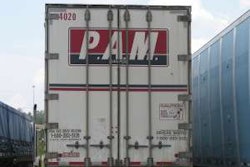
Universal Truckload Services Inc. last week announced financial results for the 13- and 26-week periods ended July 3. For the 13-week period, operating revenues including fuel surcharges increased 28.7 percent, or $34.4 million, to $154.3 million from $119.9 million for the 13 weeks ended June 27, 2009. Net income increased by $3.3 million to $4.6 million from $1.3 million.
Universal’s truckload revenue increased by 29.3 percent to $97.1 million from $75.1 million; included in truckload revenue is $12.7 million of revenue from acquisitions completed since the third quarter of 2009. Brokerage revenue increased by 33.1 percent to $34.8 million from $26.1 million; included in brokerage revenue is $7.9 million of revenue from the same acquisitions. Intermodal revenue increased by 20.2 percent to $22.5 million from $18.7 million.
For the 26-week period, operating revenues including fuel surcharges increased 24.9 percent, or $58.4 million, to $293.3 million from $234.9 million for the 26-week period ended June 27, 2009. Net income increased by $5.2 million to $6.6 million from $1.4 million.
Universal’s truckload revenue increased by 27.5 percent to $183.3 million from $143.8 million; included in truckload revenue is $24.0 million from acquisitions completed since the third quarter of 2009. Brokerage revenue increased by 24.7 percent to $67.2 million from $53.9 million; included in brokerage revenue is $14.9 million from the same acquisitions. Intermodal revenue increased by 15.2 percent to $42.9 million from $37.3 million.
“Our second quarter has been a continuation of trends seen earlier in the year,” said Don Cochran, president and chief executive officer of the Warren, Mich.-based company. “Load counts, rates and margins are showing signs of recovery in the truckload, brokerage and intermodal segments of the business. We are encouraged with the economic climate and our results in the second quarter, and we are cautiously optimistic that these trends will continue for the second half of 2010.”









